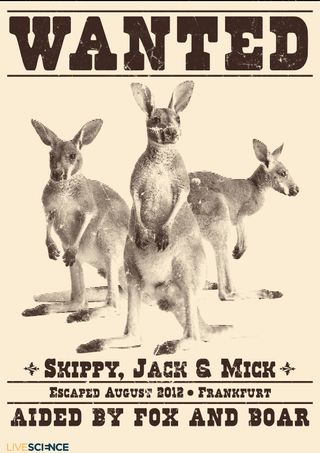On the Lam: 10 of the Greatest Animal Escape Artists
Now you see me...

It's still considered a rare feat for animals to escape from zoos, but occasionally, there are intrepid creatures that find themselves on the other side of their enclosures. And when that happens, the stories surrounding the escapes can be wild, hilarious and downright daring. Here are tales of some of the greatest animal escape artists.
Taste of freedom

Sunny the red panda disappeared from the Virginia Zoo, in Norfolk, in late January 2017. According to zoo officials, the 19-month-old red panda made her daring escape on a stormy night, likely after her male companion, Thomas, tried to pursue her. (Sunny escaped during the red panda's breeding season.)
While most escaped zoo animals are found within hours or days, Sunny is amazingly still on the lam. The raccoon-like critter has so far evaded search efforts that included the use of infrared cameras and drones. Trained dog units and volunteers have also combed the streets and parks surrounding the Virginia Zoo, but have not caught sight of the crafty red panda.
Ride or die

Intrigue. Romance. Freedom.
Well, sort of. This capybara duo came to be known as Bonnie and Clyde after the pair broke out of High Park Zoo in Toronto, Canada. The fugitive capybaras fled during a transfer on May 24, 2016, and spent more than a month on the run. The furry duo made international headlines (though not for sticking up banks like their namesakes, thankfully), with people even tweeting updates with the hashtag #CapybaraWatch.
Bonnie and Clyde were eventually recaptured in traps set by the Toronto Wildlife Centre. And it seems the pair has now settled into a more domestic routine: High Park Zoo announced in March 2017 that Bonnie and Clyde are now parents to three baby capybaras.
Repeat offender

Think of Ken Allen as the godfather of zoo escapes. The Borneo orangutan's antics, already part of zoo lore, earned him the nickname "Houdini." Why? Because Ken Allen managed to escape his enclosure at the San Diego Zoo on three separate occasions.
Ken Allen's first brush with freedom occurred on June 13, 1985, when the 250-pound (113 kilograms) orangutan scaled a wall in his enclosure and took a stroll down one of the zoo's public paths. Ken Allen broke free for a second time on July 29, 1985, and amazingly, the escapes didn't end there. In fact, the orangutan got even more creative, and even recruited other apes to help. On Aug. 13, 1985, Ken Allen made his third break for freedom, after finding a crowbar that zookeepers had accidentally left behind in his pen. In a remarkable display of cunning, Ken Allen tossed the crowbar to a fellow orangutan named Vicki, who used it to open up a window and let him out.
The orangutan became one of the most famous animals, and at one point, even had a fan club. Sadly, Ken Allen developed cancer and died in 2000 at the age of 29.
Have you ssss-een me?

New Yorkers are a famously unflappable bunch, but when an Egyptian cobra was reported missing at the Bronx Zoo, more than a few locals were on edge.
After a seven-day search, the deadly cobra was found alive and well in a non-public, off-exhibit area of the Bronx Zoo's Reptile House. Thankfully, the slithery creature had never actually left the building. Rather, zoo staff said the female cobra, who was only months old at the time was hiding in one of the holding areas of the Reptile House — a complex area chock full of pumps, motors and other mechanical systems.
Splish, splash

For more than two months in 2012, this Humboldt penguin was the most-wanted creature in Japan.
In March 2012, Penguin 337 climbed a rock wall at Tokyo Sea Life Park, slipped through a barbed wire fence and spent 82 days on the lam. And it seemed the penguin enjoyed its taste of freedom; on one occasion, the carefree critter was reportedly spotted splashing around in Tokyo Bay. Zookeepers received multiple tips about the penguin's whereabouts, and it was eventually recaptured safe and sound.
Red panda on the run

Sunny is not the only red panda with a taste for the outside world. On June 24, 2013, Rusty the red panda fled the Smithsonian National Zoo in Washington, D.C. At the time, zoo officials said heavy rain likely caused branches in Rusty's enclosure on the zoo's "Asia Trail" to bend more than usual toward the edge of the exhibit, enabling the intrepid red panda to hop out and stroll the streets of the nation's capital.
After an exhaustive search, Rusty was found in the Adams Morgan neighborhood, nearly 1 mile (1.6 kilometers) away from the zoo.
Sign up for the Live Science daily newsletter now
Get the world’s most fascinating discoveries delivered straight to your inbox.
Grumpy fugitive

In July 2016, a lynx named Flaviu went missing for more than three weeks from the Dartmoor Zoological Park near the village of Sparkwell, in the United Kingdom. Flaviu escaped a day after he arrived at the zoo. chewing through a board in the wall of his enclosure to get out, according to zookeepers.
Flaviu killed four lambs on a nearby farm before he was recaptured and returned to the park. Though the lynx was safe and sound, zoo officials said he was "grumpy," and reported that they were trying to find Flaviu a female companion to lift his mood.
Are you in or out?

It's a dilemma that zoos don't often face: In April 2012, a wild Bengal tiger ventured out of the forest and broke into the Nandankanan Zoo in India. Officials said the 6-year-old male tiger was likely attracted to the zoo's captive female tiger, and he was found roaming around her enclosure.
But alas, the tiger love story was not meant to be. After a few weeks of living contentedly at the zoo, the wild tiger scaled the enclosure's two-story security wall and reclaimed his freedom. Zoo officials, stunned by the tiger's getaway, were subsequently unable to track down the big cat's whereabouts.
Close to home

Ollie disappeared from her enclosure at the Smithsonian National Zoo in Washington, D.C., on Jan. 30, 2017. The 6-year-old bobcat was missing for two days, prompting some nearby schools to cancel recess, even though zoo officials did not consider Ollie a threat to humans.
In the end, the bobcat did not wander too far, and she was eventually found on zoo grounds, near the facility's birdhouse.
Three's trouble

It's hard enough for one animal to escape a zoo, but in August 2012, a trio of kangaroos fled a wildlife park in Germany. The troublemaking kangaroos — Skippy, Jack and Mick — escaped from Hochwildschutzpark Hunsrück, near Frankfurt, with help from a wild boar and fox. The unwitting accomplices had dug holes under the park's fences, enabling the kangaroo trio to squeeze under and make a hop for freedom. One kangaroo was recaptured on the park's grounds, and another was caught after a chase, but the third eluded park officials.

Denise Chow was the assistant managing editor at Live Science before moving to NBC News as a science reporter, where she focuses on general science and climate change. Before joining the Live Science team in 2013, she spent two years as a staff writer for Space.com, writing about rocket launches and covering NASA's final three space shuttle missions. A Canadian transplant, Denise has a bachelor's degree from the University of Toronto, and a master's degree in journalism from New York University.
